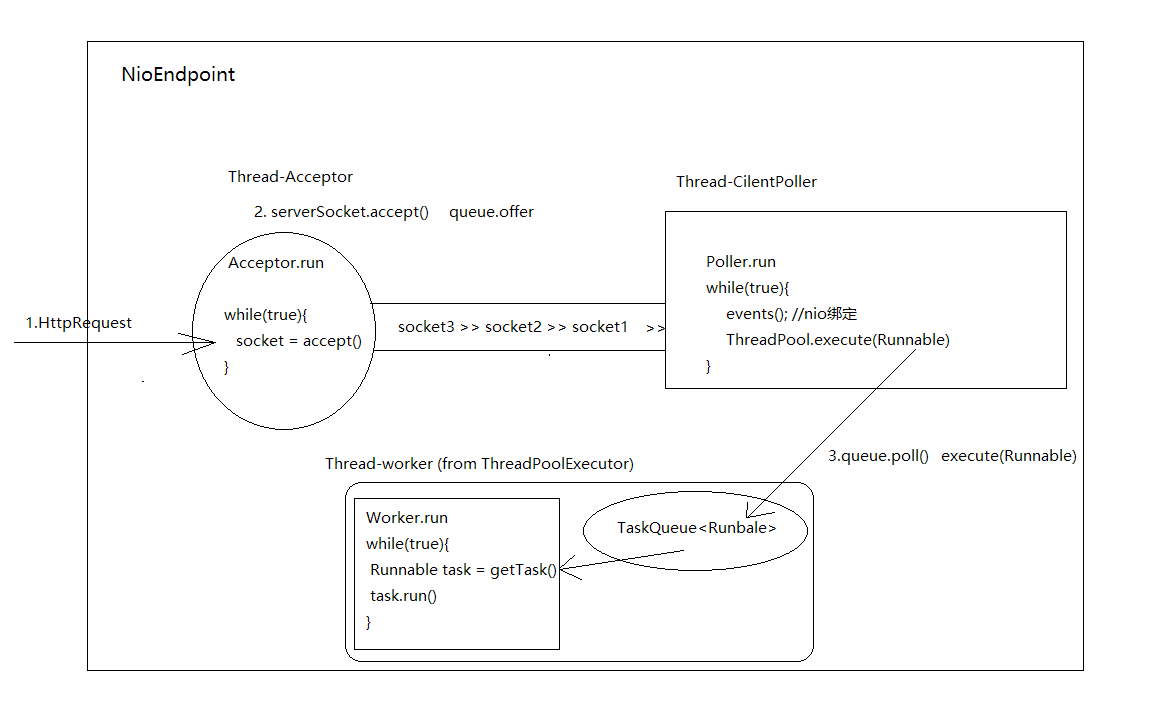tomcat-如何建立连接,获取远程请求
学习探讨tomcat如何建立网络连接协议,并处理客户端过来的请求
建立网络连接,指定http1.1通信协议
tomcat在创建时,会创建连接对象,负责处理客户端的请求,基于socket
connector 连接 protocol 协议 endpoint终端 socket插座,端口连接
创建初始化,对象创建顺序
connector > protocol > endpoint > socket
接收请求创建任务
acceptor.socket.acceptor()->
socketWrapper(携带通信信息)
-> poller(socketWrapper)
-> execute(socketWrapper) 创建线程

创建连接器
Conector类
org.apache.catalina.connector.Connector
空参构造connector() -> connector(http/1.1)
/** * Defaults to using HTTP/1.1 NIO implementation. */public Connector() { this("HTTP/1.1");}指定通信协议http11
类
org.apache.coyote.http11.Http11NioProtocol
-> new Http11NioProtocol()
public Http11NioProtocol() { super(new NioEndpoint()); }指定服务终端处理模型非阻塞nio
类
org.apache.tomcat.util.net.NioEndpoint
-> new NioEndPoint()
创建之后如何被启动?见springboot启动tomcat方式
终端处理线程和线程池初始化
启动之后
NioEndpoint执行bind()方法,
一些初始化,绑定端口
@Override public void bind() throws Exception { initServerSocket(); setStopLatch(new CountDownLatch(1)); // Initialize SSL if needed initialiseSsl(); selectorPool.open(getName()); }
//socket相关 initServerSocket()具体如下 // Separated out to make it easier for folks that extend NioEndpoint to // implement custom [server]sockets protected void initServerSocket() throws Exception { //....... //根据平台不同,反回具体底层类对象(windows,linux,unix) serverSock = ServerSocketChannel.open(); socketProperties.setProperties(serverSock.socket()); //绑定地址和端口号 InetSocketAddress addr = new InetSocketAddress(getAddress(), getPortWithOffset()); serverSock.socket().bind(addr,getAcceptCount()); //....... }NioEndpoint初始化之后,调用start()执行startInternal()
代码如下
// Create worker collectionif (getExecutor() == null) { //创建线程池 createExecutor();}
initializeConnectionLatch();// Start poller thread// 创建客户端队列(客户端过来的请求)
poller = new Poller();Thread pollerThread = new Thread(poller, getName() + "-ClientPoller");pollerThread.setPriority(threadPriority);pollerThread.setDaemon(true);pollerThread.start();
//创建接收远程请求线程startAcceptorThread();初始化线程池配置
-> createExecutor() 用于处理用户请求
指定 备用线程,对大线程数,队列类型,超时时间,和线程工厂
public void createExecutor() { internalExecutor = true; TaskQueue taskqueue = new TaskQueue(); TaskThreadFactory tf = new TaskThreadFactory(getName() + "-exec-", daemon, getThreadPriority()); executor = new ThreadPoolExecutor(getMinSpareThreads(), getMaxThreads(), 60, TimeUnit.SECONDS,taskqueue, tf); taskqueue.setParent( (ThreadPoolExecutor) executor); }创建Poller线程
poller = new Poller();Thread pollerThread = new Thread(poller, getName() + "-ClientPoller");pollerThread.setPriority(threadPriority);pollerThread.setDaemon(true);pollerThread.start();创建Acceptor线程
protected void startAcceptorThread() { acceptor = new Acceptor<>(this); String threadName = getName() + "-Acceptor"; acceptor.setThreadName(threadName); Thread t = new Thread(acceptor, threadName); t.setPriority(getAcceptorThreadPriority()); t.setDaemon(getDaemon()); t.start(); }处理请求的相关对象(线程)
Acceptor
类
org.apache.tomcat.util.net.Acceptor
Acceptor 负责循环等待远程请求,将请求以socket形式携带信息,调用setSocketOptions()将socket包装配置为socketWrapper,
setSocketOptions: 对socket包装处理配置,使用poller对象注册到队列,让poller线程做后续的处理
Acceptor 类的run方法:
public void run() {
int errorDelay = 0; //......以下省略部分代码 try { // Loop until we receive a shutdown command // 一直循环等待远程请求 while (!stopCalled) { // Accept the next incoming connection from the server socket // 1 接收请求 socket = endpoint.serverSocketAccept();
// setSocketOptions() will hand the socket off to // 2 处理请求,setSocketOptions() 内部调用poller 将新请求任务放入队列 if (!endpoint.setSocketOptions(socket)) { endpoint.closeSocket(socket); }
} } finally { stopLatch.countDown(); } state = AcceptorState.ENDED; }Poller
类
org.apache.tomcat.util.net.NioEndpoint.Poller
Poller负责接收包装后的socket请求,放入队列,
并在run方法中循环去poll()请求任务,将与流读写有关的组件IOChannel Selector socketWrapper 绑定关联
再通过selector获取selectionKeys
迭代循环获取对应的socket,提交任务(线程),线程读写处理socketWrapper等后续操作
public void run() { // Loop until destroy() is called while (true) { // events()方法 poller队列任务处理 将IOChannel Selector socketWrapper 关联 hasEvents = events(); //......省略
Iterator<SelectionKey> iterator = keyCount > 0 ? selector.selectedKeys().iterator() : null; // Walk through the collection of ready keys and dispatch // 非阻塞io api 任务处理 while (iterator != null && iterator.hasNext()) { SelectionKey sk = iterator.next(); iterator.remove(); NioSocketWrapper socketWrapper = (NioSocketWrapper) sk.attachment(); // Attachment may be null if another thread has called // cancelledKey() if (socketWrapper != null) { // 如果有等待处理的任务,则处理 processKey(sk, socketWrapper); //processKey内部会调用processSocket方法,最终用线程池提交任务 } }
// Process timeouts timeout(keyCount,hasEvents); }
getStopLatch().countDown(); }调用线程池处理请求
org.apache.tomcat.util.net.AbstractEndpoint
public boolean processSocket(SocketWrapperBase<S> socketWrapper, SocketEvent event, boolean dispatch) { try { if (socketWrapper == null) { return false; } SocketProcessorBase<S> sc = null; if (processorCache != null) { sc = processorCache.pop(); } if (sc == null) { sc = createSocketProcessor(socketWrapper, event); } else { sc.reset(socketWrapper, event); } Executor executor = getExecutor(); //获取线程池 if (dispatch && executor != null) { executor.execute(sc); //最终通过线程池处理配置后的请求 } else { sc.run(); } } catch (RejectedExecutionException ree) { getLog().warn(sm.getString("endpoint.executor.fail", socketWrapper) , ree); return false; } catch (Throwable t) { ExceptionUtils.handleThrowable(t); // This means we got an OOM or similar creating a thread, or that // the pool and its queue are full getLog().error(sm.getString("endpoint.process.fail"), t); return false; } return true;events队列
private final SynchronizedQueue<PollerEvent> events = new SynchronizedQueue<>(); //事件队列(socket请求)//注册请求到队列public void rigister(final NioSocketWrapper socketWrapper){ event = new PollerEvent(socketWrapper, OP_REGISTER); addEvent(event);}
private void addEvent(PollerEvent event) { events.offer(event); if (wakeupCounter.incrementAndGet() == 0) { selector.wakeup(); }}其他
events()绑定及后面的 processSocket()最终提交实际处理任务到线程
/** * Processes events in the event queue of the Poller. * * @return <code>true</code> if some events were processed, * <code>false</code> if queue was empty */ public boolean events() { boolean result = false;
PollerEvent pe = null; for (int i = 0, size = events.size(); i < size && (pe = events.poll()) != null; i++ ) { result = true; NioSocketWrapper socketWrapper = pe.getSocketWrapper(); SocketChannel sc = socketWrapper.getSocket().getIOChannel(); int interestOps = pe.getInterestOps(); if (sc == null) { log.warn(sm.getString("endpoint.nio.nullSocketChannel")); socketWrapper.close(); } else if (interestOps == OP_REGISTER) { try { //注册绑定 sc.register(getSelector(), SelectionKey.OP_READ, socketWrapper); } catch (Exception x) { log.error(sm.getString("endpoint.nio.registerFail"), x); } } else { final SelectionKey key = sc.keyFor(getSelector()); if (key == null) { // The key was cancelled (e.g. due to socket closure) // and removed from the selector while it was being // processed. Count down the connections at this point // since it won't have been counted down when the socket // closed. socketWrapper.close(); } else { final NioSocketWrapper attachment = (NioSocketWrapper) key.attachment(); if (attachment != null) { // We are registering the key to start with, reset the fairness counter. try { int ops = key.interestOps() | interestOps; attachment.interestOps(ops); key.interestOps(ops); } catch (CancelledKeyException ckx) { cancelledKey(key, socketWrapper); } } else { cancelledKey(key, socketWrapper); } } } if (running && !paused && eventCache != null) { pe.reset();//清空任务socketWrapper eventCache.push(pe); } }
return result; }setSocketOptions 中的socket任务注册
protected boolean setSocketOptions(SocketChannel socket) { NioSocketWrapper socketWrapper = null; try { // Allocate channel and wrapper NioChannel channel = null; if (nioChannels != null) { channel = nioChannels.pop(); } //...... 部分省略 NioSocketWrapper newWrapper = new NioSocketWrapper(channel, this);
socketWrapper.setKeepAliveLeft(NioEndpoint.this.getMaxKeepAliveRequests()); poller.register(socketWrapper); return true; } catch (Throwable t) { ExceptionUtils.handleThrowable(t); try { log.error(sm.getString("endpoint.socketOptionsError"), t); } catch (Throwable tt) { ExceptionUtils.handleThrowable(tt); } if (socketWrapper == null) { destroySocket(socket); } }